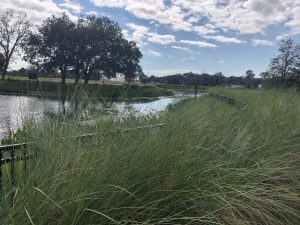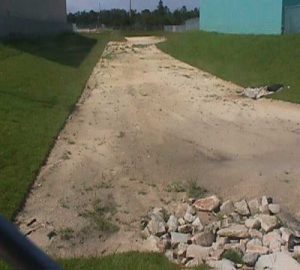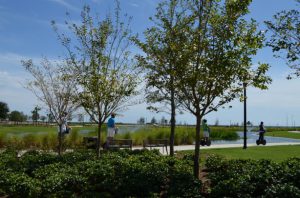
Well-maintained stormwater ponds can become attractive amenities that also improve water quality. Photo credit: Carrie Stevenson, UF IFAS Extension
Prior to joining UF IFAS Extension, I spent three years as a compliance and enforcement field inspector with the local Florida Department of Environmental Protection (FDEP) office. It was a crash course in drinking water regulation, wetlands ecology, stormwater engineering, and human psychology. For about half of that time, I worked in the stormwater section with an engineer, certifying the proper construction and specifications of stormwater treatment ponds built for residential and commercial developments. During a construction boom in 2000-2003, my coworkers and I traversed back roads from Perdido Key to Freeport, trying to catch every new project and make sure it was done right. If they weren’t, it also fell to the 3 of us to make sure mistakes were corrected.
Since 1982, Florida Statutes have required that rainfall landing on newly constructed impervious surfaces (rooftops, streets, parking lots, etc.) must be treated before turning into runoff that leaves the property and ends up in local water bodies. The pollutants in stormwater runoff—heavy metals, fertilizer, pesticides, trash, bacteria, and sediment—are the biggest sources of water quality problems for the state, more so even than industrial and agricultural sources.

The most common stormwater ponds have sandy bottoms, grassed berms, and piped inlets with riprap to slow the influx of water. Photo credit, Michelle Diller
Therefore, new developments are required to treat that runoff. This may be accomplished by several means, including regional stormwater ponds. However, the most common are still curbs and gutters, which drain to an often-rectangular hole in the ground with a chain-link fence around it. Ideally, water pools into these dry ponds while raining, reducing flood risk and holding water long enough to allow it to soak into the soil. Most of the ponds in northwest Florida have sandy bottoms that percolate easily. Maintenance is required, however, and when heavier soils, trash, or muck accumulate they must be cleaned out to function properly. Depending on the geology of any given location, the ponds may need sand filters or “chimneys” added to allow water to soak into the native soil.

Admiral Mason Park, adjacent to the Veterans’ Memorial Park along Pensacola Bay, is an example of a regional City stormwater treatment facility that also serves as a park. Photo credit: Visit Pensacola
If an area is naturally low-lying, close to the water table, or has highly organic, water-holding soils, it may be necessary to construct a “wet” stormwater pond. In these, water stands to a level below an overflow device, and can become a water feature for the development. Many residential developers will sell lots around a stormwater pond as “waterfront property” and a well-maintained one really can be a nice amenity. However, at their core, these are stormwater treatment mechanisms. A wet pond functions differently than a dry one and is dependent on healthy stands of shoreline vegetation to take up extra nutrients, metabolize them, and render them into harmless compounds. Many of these ponds have fountains to aerate the water and keep them from becoming stagnant. The City of Pensacola and Escambia County have several great examples of these types of ponds that serve as regional stormwater detention and community amenities. These were constructed in lower-lying areas to handle chronic problems with stormwater in areas that were built up and paved many decades before stormwater rules came into effect. Many other innovative and newer stormwater treatments exist as well, including bioretention, rainwater harvesting, green roofs, and pervious pavement.
- Hurricane Season 2025 - July 7, 2025
- The Striped Burrfish - April 11, 2025
- The Value of Biodiversity - March 28, 2025
